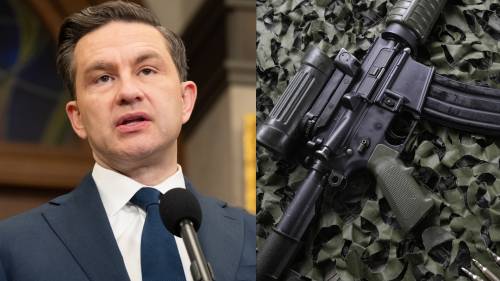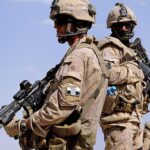The winds of change are gusting through Canada’s military establishment this week as Opposition Leader Pierre Poilievre called for a dramatic shift in our armed forces’ approach. Speaking at a press conference in Halifax yesterday, Poilievre advocated for what he described as a “warrior culture” within the Canadian military—a significant departure from recent defence policy discussions.
“We need a warrior culture in our military,” Poilievre declared, flanked by several Conservative MPs at the Halifax shipyard. “The job of our military is to kill bad guys and break their toys.”
His blunt characterization raised eyebrows among defence analysts and veterans’ groups, coming just days after the Liberal government announced plans to boost military spending to 1.76 percent of GDP by 2030. While this increase falls short of NATO’s 2 percent target, it represents approximately $8.1 billion in additional defence funding over the next five years.
David Perry, president of the Canadian Global Affairs Institute, noted the significance of Poilievre’s language choice. “This represents a fundamental reframing of how Conservatives would position military culture if elected,” Perry told me during a phone interview. “It’s less about peacekeeping and more about combat readiness.”
The timing of Poilievre’s remarks coincides with growing geopolitical tensions worldwide and increasing pressure from NATO allies for Canada to shoulder more of the collective defence burden. Recent polling from Abacus Data suggests 62 percent of Canadians support increased military spending, though opinions diverge sharply on priorities.
Defence Minister Bill Blair responded to Poilievre’s comments with measured criticism. “Our government recognizes the complex nature of modern military operations which include humanitarian missions, peacekeeping, and yes, combat operations when necessary,” Blair stated during Question Period. “Reducing our forces to a single dimension misunderstands the multifaceted role Canada plays on the world stage.”
For communities like Halifax with deep military connections, the debate hits close to home. At the Tim Hortons near CFB Halifax, I spoke with retired Master Corporal James Dennison, who offered a nuanced perspective.
“There’s something to be said for combat readiness—that’s undeniable,” Dennison remarked while stirring his coffee. “But the Canadian Forces have always balanced that with humanitarian work. Our reputation wasn’t built on being warriors alone.”
The tension between these visions reflects broader questions about Canada’s international role. The Liberal government’s defence policy update, released last April, emphasized modernization, Arctic sovereignty, and cyber capabilities without specifically advocating for the kind of cultural shift Poilievre describes.
Military historian Dr. Andrea Charron from the University of Manitoba points out that this isn’t just semantics. “Language matters tremendously in military institutions,” she explained. “A ‘warrior culture’ evokes certain traditions and priorities that would reshape training, recruitment, and operational doctrine.”
Veterans’ organizations have expressed mixed reactions. The Royal Canadian Legion issued a carefully worded statement emphasizing the importance of “professional military ethos” while Veterans for Peace Canada more directly criticized Poilievre’s characterization as “oversimplified and potentially harmful.”
Behind the political positioning lies a genuine debate about military readiness. Canada’s forces have faced equipment shortages, recruitment challenges, and aging infrastructure. The frigate replacement program is years behind schedule, and the RCAF continues to fly aging CF-18 fighters while waiting for F-35 deliveries.
Colonel (Ret.) Michel Drapeau, now a military law expert, suggests the focus should be elsewhere. “Whether you call them warriors or peacekeepers, what our personnel need most is adequate equipment, proper housing, and timely healthcare when they return from deployments,” he said during a CBC Radio interview this morning.
In ridings with military bases, the messaging resonates differently. Conservative MP James Bezan, who represents Selkirk-Interlake-Eastman, has been touring military communities emphasizing the need for “combat-effective forces.” His reception has been notably warmer in areas directly connected to the Canadian Forces.
For Indigenous communities with strong military participation rates, the framing carries additional complexity. Debbie Eisan, a Mi’kmaq veteran who served 36 years in the Royal Canadian Navy, told me, “Many Indigenous people join the forces with a sense of protecting community and territory—not necessarily with a warrior identity as Poilievre describes it.”
As political parties position themselves ahead of a potential election, defence policy is emerging as an unexpectedly prominent wedge issue. Conservative strategists clearly see vulnerability in the Liberals’ approach to military spending and culture, while the government emphasizes continuity and measured increases.
What remains unclear is how this rhetoric might translate into concrete policy. Would a “warrior culture” mean different recruitment standards? Changes to training? Different deployment priorities? These questions remain unanswered in the current debate.
For now, Canadians are left to consider what kind of military best represents their values and interests on the global stage. As Halifax shipyard worker Trevor MacIntosh put it while watching Poilievre’s press conference from across the street: “I just want to know our forces have what they need to do their jobs and come home safe. The rest feels like politics.”
Whether Poilievre’s call for a “warrior culture” represents a substantive policy shift or campaign positioning will likely become clearer as both parties continue to develop their defence platforms in the months ahead.






